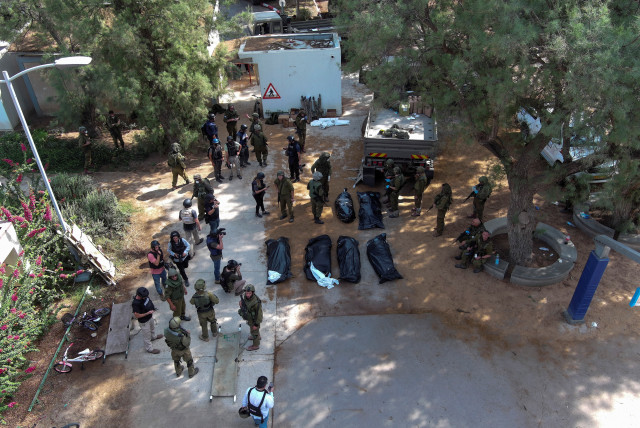Israel struggles to identify victims of Hamas mass murder attack

Bodies of 361 Israelis identified out of 854 found so far; 222 soldiers killed, families of 97 hostages informed by authorities.
As the fist week of the war following Hamas’s massacre of communities in the South comes to a close, and Israelis prepare for Shabbat, authorities are continuing to identify the bodies of victims.
By Thursday afternoon, the bodies of 854 citizens had been collected and were brought to an identification point, with 361 identified and 264 buried.
Overall estimates continue to indicate that more than 1,300 were killed in the attack, mostly civilians, at the Nova music festival and 20 communities along the Gaza border, with the death toll at Kibbutz Be’eri and Kfar Aza bearing the highest brunt, with reports of 100 victims in each town.
A total of 222 soldiers have been confirmed killed, and their families have been notified. By Thursday, 138 have been buried. Although not all the victims are Jewish, generally in Jewish custom it is typical to bury people as quickly as possible. Families now await notification and also want to know if their loved ones are missing.
The great challenge faced by authorities is unlike anything Israel has ever dealt with. With the bodies of more than 1,200 to be collected, one of the greater struggles remains that some are difficult to identify, some reports showing bodies that some were burned or disfigured.
Crossreferenced with database
Israel has a database of its civilians. For instance, when soldiers are recruited, they provide DNA, fingerprints and photographs of teeth for identification purposes. In this situation, it is critical that all identification be done to its fullest extent, and that no mistakes are made. This is why authorities are working systematically and as fast as possible; but this takes time.
The projected time-frame was to have all the identifications done by Shabbat, but it may extend further. The identifications are being conducted by a mix of IDF, Israel Police, and other organizations and government bodies, with the purpose of having a systematic process and also informing families correctly, not have families find out in other ways – such as through social media – and be traumatized more.
Additionally, building a database from each victim takes time. DNA must be taken, and in cases where identification is difficult, dental records and other details must be examined, including those of foreign workers who were also massacred on the border, Thais and Nepalis, as well as other victims, such as foreign tourists.
In terms of hostages, authorities are working to notify the families of the hostages still in Gaza; so far, 97 families have been notified. Israel is attempting to improve the response time, enlisting more soldiers to help in the process, working around the clock.
Another issue faced by the country is the more than 1,000 bodies reportedly of terrorists found in the area. These are taken to a separate place and also identified, although the process with them is less clear.
Jerusalem Post Store
`; document.getElementById("linkPremium").innerHTML = cont; var divWithLink = document.getElementById("premium-link"); if (divWithLink !== null && divWithLink !== 'undefined') { divWithLink.style.border = "solid 1px #cb0f3e"; divWithLink.style.textAlign = "center"; divWithLink.style.marginBottom = "15px"; divWithLink.style.marginTop = "15px"; divWithLink.style.width = "100%"; divWithLink.style.backgroundColor = "#122952"; divWithLink.style.color = "#ffffff"; divWithLink.style.lineHeight = "1.5"; } } (function (v, i) { });

